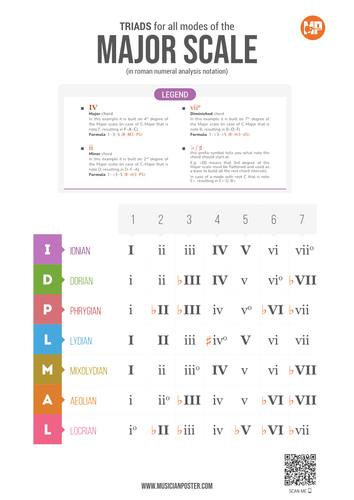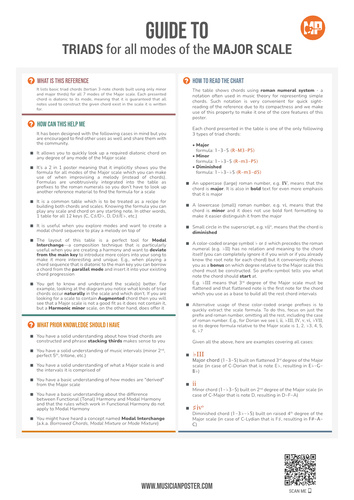This reference chart lists basic diatonic triad chords for all 7 modes of the Major scale in roman numeral analysis notation. Such notation makes it a generic chart that covers all 12 scale root tones for each mode.
How to Read the Chart?
Each chord presented in the table is one of the only following 3 types of triad chords:
- Major
formula: 1-3-5 (R-M3-P5) - Minor
formula: 1-b3-5 (R-m3-P5) - Diminished
formula: 1-b3-b5 (R-m3-d5)
The meaning of roman numerals and special symbols:
- An uppercase (large) roman number, e.g. IV, means that the chord is major. It is also in bold text for even more emphasis that it is major
- A lowercase (small) roman number, e.g. vi, means that the chord is minor and it does not use bold font formatting to make it easier distinguish it from the major
- Small circle in the superscript, e.g. viio, means that the chord is diminished
- A color-coded orange symbol b or # which precedes the roman numeral (e.g. bII) has no relation and meaning to the chord itself (you can completely ignore it if you wish or if you already know the root note for each chord) but it conveniently shows you as a bonus on which degree relative to the Major scale this chord must be constructed. So prefix-symbol tells you what note the chord should start at. E.g. bIII means that 3rd degree of the Major scale must be flattened and that flattened note is the first note for the chord which you use as a base to build all the rest chord intervals
- Alternative usage of these color-coded orange prefixes is to quickly extract the scale formula. To do this, focus on just the prefix and roman number, omitting all the rest, including the case of roman number. E.g., for Dorian we see i, ii, bIII, IV, v, vi, bVII, so its degree formula relative to the Major scale is 1, 2, b3, 4, 5, 6, b7
Given all the above, here are examples covering all cases:
- bIII
Major chord (1-3-5) built on flattened 3rd degree of the Major scale (in case of C-Dorian that is note Eb, resulting in Eb-G-Bb) - ii
Minor chord (1-b3-5) built on 2nd degree of the Major scale (in case of C-Major that is note D, resulting in D-F-A) - #ivo
Diminished chord (1-3b-b5) built on raised 4th degree of the Major scale (in case of C-Lydian that is F#, resulting in F#-A-C)
How You Can Use This Chart
It has been designed with the following cases in mind but you are encouraged to find other uses as well and share them with the community.- It allows you to quickly look up a required diatonic chord on any degree of any mode of the Major scale.
- It's a 2 in 1 poster meaning that it implicitly shows you the formula for all modes of the Major scale which you can make use of when improvising a melody (instead of chords). Formulas are unobtrusively integrated into the table as prefixes to the roman numerals so you don't have to look up another reference material to find the formula for a scale.
- It is a common table which is to be treated as a recipe for building both chords and scales. Knowing the formula you can play any scale and chord on any starting note. In other words, 1 table for all 12 keys (C, C#/Db, D, D#/Eb, etc.).
- It is useful when you explore modes and want to create a modal chord sequence to play a melody on top of.
- The layout of this table is a perfect tool for Modal Interchange - a composition technique that is particularly useful when you are creating a harmony and want to deviate from the main key to introduce more colors into your song to make it more interesting and unique. To do so, you can borrow a chord from the parallel mode and insert it into your existing chord progression. Parallel mode simply means it starts with the same root note as your main key.
- You get to know and understand the scale(s) better. For example, looking at the diagram you notice what kinds of triad chords occur naturally in the scale and which don't. If you are looking for a scale to contain Augmented chord then you will see that a Major scale is not a good fit as it does not contain it, but a Harmonic minor scale, on the other hand, does offer it.












1 Comment
What do you think of this one? I'm interested in all aspects, not just music-related, any thoughts. For example, do you like it when it is colorful? Or would you rather prefer a more calm look? Do you like it when the guide/legend to the poster is on the poster itself or on a separate sheet? I will use your feedback for future posters.
And I would sincerely appreciate a helping hand in spreading out the word: if you like my work, find it useful and want to see more of it, please share a link with your friends, make a re-post or give a like. Anything helps, really!